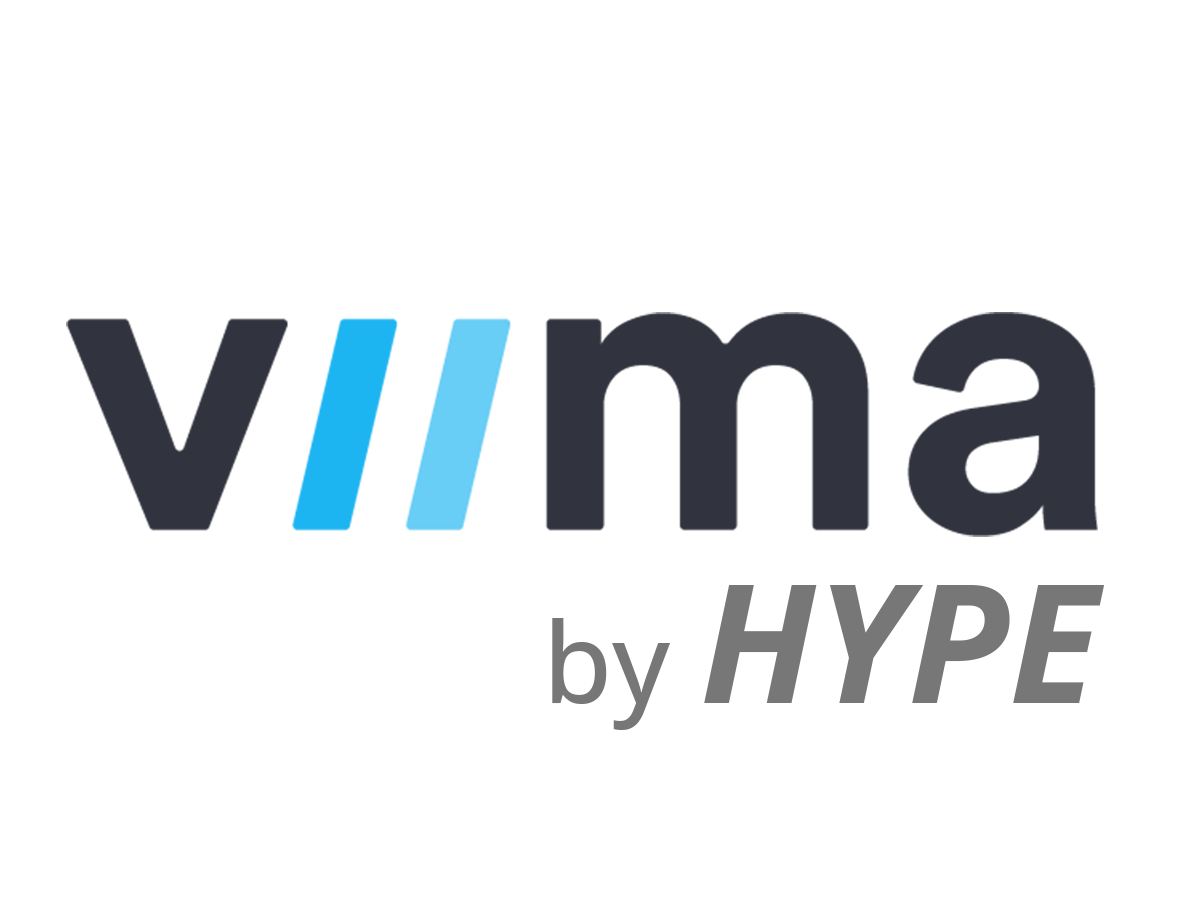Innovation Beyond the Core with John Carter
In this episode of the Innovation Room podcast, John Carter shares his thoughts on why companies should look beyond their core in their innovation efforts.
Namely, innovation beyond the core often leads to high margin growth opportunities, and is also easier, faster, and more affordable. John also shares his thoughts on how companies can actually tackle these opportunities and make the most out of them.
As some of you may remember, John is the founder of TCGen. Throughout his career, he's advised a number of world class companies like Apple and Amazon with their product development and innovation processes.
Table of contents
What is Innovation Beyond the Core?
JESSE: So, our topic for the day is innovation beyond the core. Most companies obviously focus most of their resources, including those for innovation, to the current core products and operations. However, you argue that companies should also go beyond that, especially if they’re looking for growth. Can you share the background of how you first got interested in the topic?
JOHN: As you know, Jesse, I was involved in innovation activities in consumer electronics early in my career at Bose, and I was really struck with how innovation can transform a company. We did it in in that area, and others as well.
And in my consulting experience, working with companies like Apple and Amazon, looking at how they go to market with their product set, I began to connect some dots on how successful companies are innovating outside the core.
I'll give you two examples of that. The forecast is for Apple by 2025 to have $50 billion in profits just from services. So, separate from iPhones, laptops, iPads or, anything. $50 billion in profit, not revenue.
The second thing is that if you look at Amazon, you think of them as The Everything Store, but they're much more than that. I'm sure you're aware of Amazon Web Services, AWS. Well, AWS right now is contributing on the order of $10 billion a quarter and it’s 70% of their profits today. AWS, a much smaller business unrelated to The Everything Store, although obviously using common infrastructure, generates more profit than the main business of Amazon itself.
So, I was wondering, what did these companies do that are different? And I started to really investigate that and did some research to find out what they did and how they were so successful. And sure, they do innovate in their core products areas, but they also innovate outside the core.
JESSE: I think at this point, it's good to clarify what we mean with the core. So, can you elaborate a bit on what you mean with the term core and what then are some examples of going beyond that?
JOHN: Sure. I think that's a great question and a reasonable clarification.
You know, it all starts with Theodore Levitt and his book called The Marketing Imagination. What he described very clearly is that a product really is a little bit vaguer than one might think. So, you typically think that the product is, let's say, an iPad or a laptop or a car.
But actually, what the consumer buys is what’s called the expected product. So that means an iPad with software to make it useful and service and support in case it breaks, and the brand of Apple reinforcing the product and its ease of use.
So, there's the core product, which is basically a computer without a keyboard using touch screen, we all know what that is. You might consider iOS 14 or whatever the current rev is, to also be included in the core product. You've got hardware and software, and so that is the core product.
But the expected product is what the consumer actually buys. It's the brand, service, support, applications and utility. Beyond that, Levitt said, there’s something called the augmented product.
You can visualize these three circles: the inner circle is the core. The next layer is the expected, and then the third layer is the augmented part of the product, and that can be all sorts of either tangible or intangible areas that the product excels in and often delights customers because it's not part of the expected product.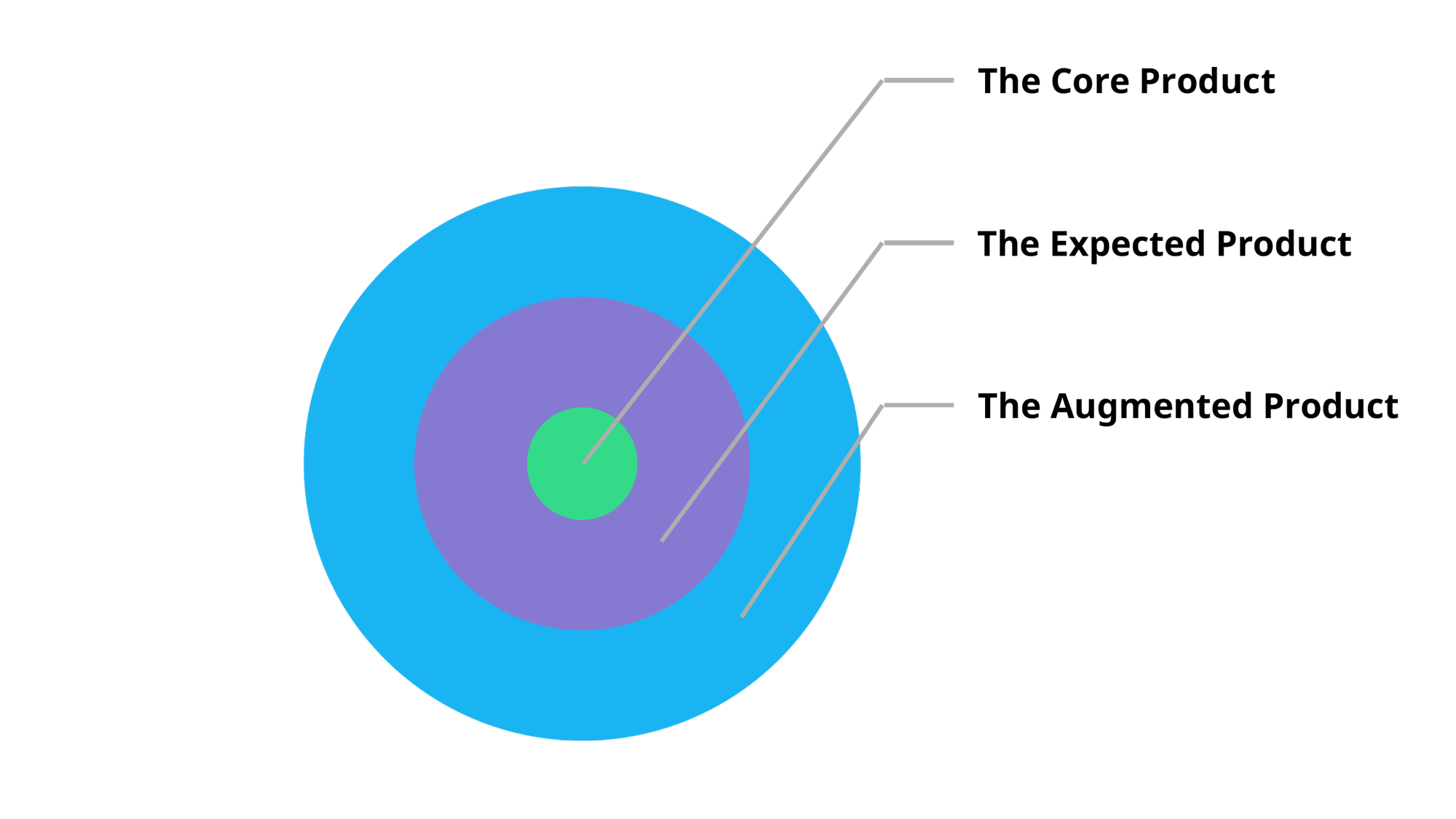 This could be additional services. It could be add-ons in terms of upgrades. I think Tesla is a great example. You buy a car, but in reality, you're buying an operating system that they can update overnight, and suddenly you've got a totally new car the next day. Who expected that? Who expected a car to be updated overnight and improved, without even taking into the shop? That's an example of the augmented product.
This could be additional services. It could be add-ons in terms of upgrades. I think Tesla is a great example. You buy a car, but in reality, you're buying an operating system that they can update overnight, and suddenly you've got a totally new car the next day. Who expected that? Who expected a car to be updated overnight and improved, without even taking into the shop? That's an example of the augmented product.
So, the core is the basic widget that people buy and that often contains the defensible innovation. You know, it might be tight software hardware integration of Apple, or the revolutionary battery technology and production techniques of Tesla.
Those are the core things, and so the tendency is that companies have a usual innovation approach, in which they’re improperly drawn to innovating around the core because they think, that that's their defensible value proposition. So, they think that that's what they should extend and magnify.
And that's not bad, I'm not saying that. One needs to continue to evolve their innovation in their core area. But the usual innovation approach is just focused on that. What we're suggesting is for organizations to also innovate around this strategy, not just the core, but looking at how you can achieve greater marketplace success with an augmented product.
And as Amazon and Apple show so clearly, there's a lot of margin in the augmented product, maybe even more so. In Amazon's case, it's more margin than in their core business.
So, these augmented areas can be very, very profitable. And if you don't allocate some investment resources to the augmented product and just focus on the core instead, you're missing all sorts of marketplace opportunities and expansion capabilities. Remember, this should be guided by your product development strategy, which describes the relative emphasis of investments in your new product activity.
If you don't allocate some investment resources to the augmented product and just focus on the core instead, you're missing all sorts of marketplace opportunities and expansion capabilities.
Benefits of investing in innovation outside the core
JESSE: You already mentioned some of these, but how do you think of the benefits of investing in these areas beyond the core?
JOHN: Well, I think there's several. The primary one is that customers want a job to be done. They don't necessarily want to buy a widget. They want a job to be done. So, innovating in the augmented product solves a bigger problem for the customer, so it's stickier.
I already mentioned the higher margins.
The third is competitive dominance. In other words, if you're able to think about the augmented product more globally, then in fact you can increase your market share and dominance because you solve a bigger problem.
There are lots of benefits, but the one that actually people don't expect is that innovation here can be easier. Innovation can be easier in the augmented product area because usually innovation in the core involves infrastructure investment, maybe brick-and-mortar, maybe an R&D lab, and a lot of fixed costs.
But if you look at the augmented product, in many cases, you can get that through machine learning and AI solutions, service and support solutions, and all other sorts of things that require much, much more modest investments.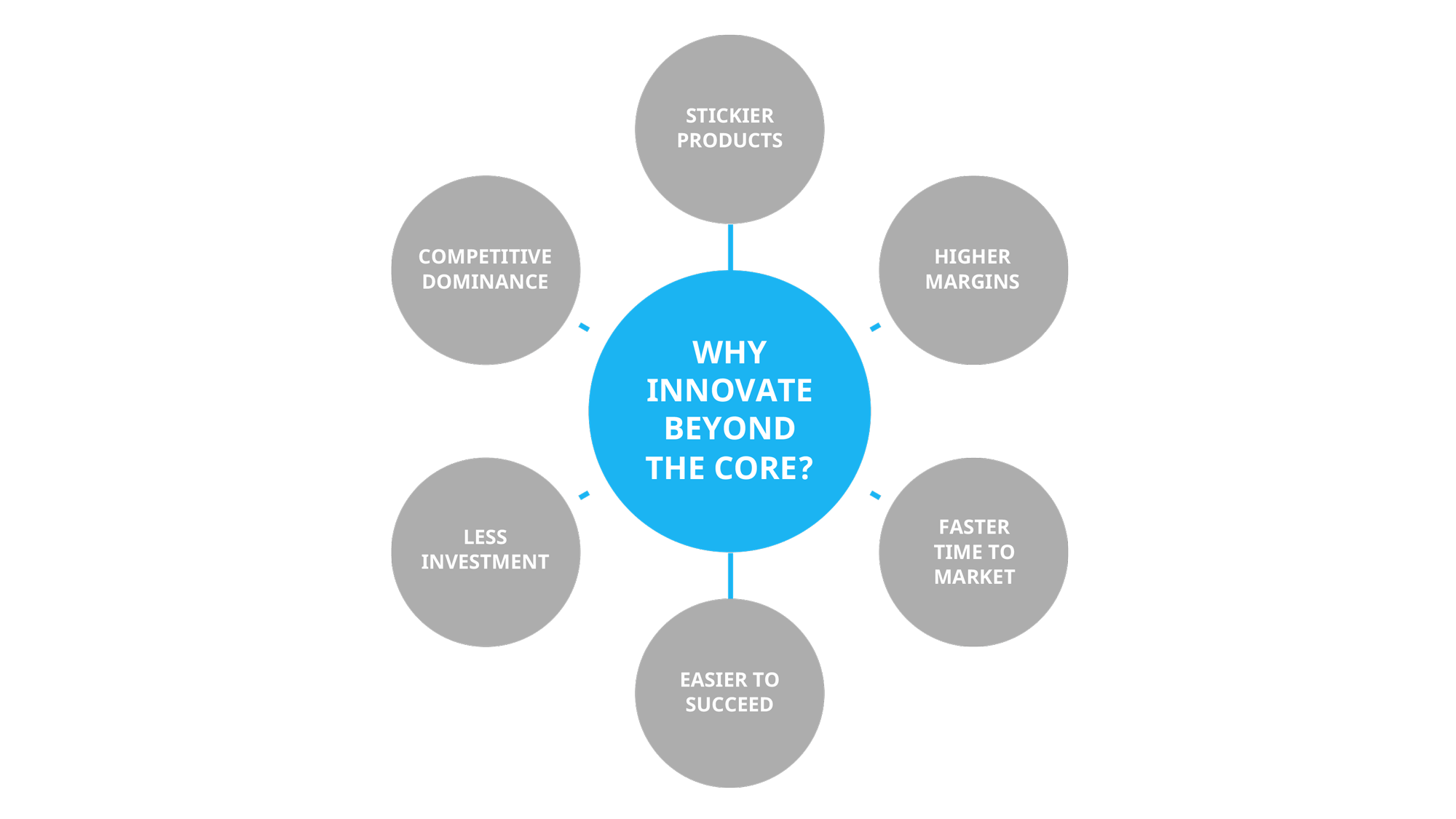 So, in fact, if you innovate outside the core, another advantage is that you actually can invest less and get more margin as a result. So, it's a very powerful technique for those who don't have an infinite budget and would really like to get some innovation out of their portfolios.
So, in fact, if you innovate outside the core, another advantage is that you actually can invest less and get more margin as a result. So, it's a very powerful technique for those who don't have an infinite budget and would really like to get some innovation out of their portfolios.
You can actually invest less and get more margin as a result if you innovate outside the core.
Oh, and related to that is the time needed to realize these innovations can be shorter as well. Innovation in the core usually requires massive investments and lots of time. Innovations for the augmented product, if you're clever, can be done for less money and in less time. So that means you can iterate and evolve much more quickly.
JESSE: Love that. And I guess a part of that comes from you already having that core in place. So, a big part of the value proposition is already there and you're just adding some new angles to that, which is where all that comes from.
JOHN: Exactly. The core has the defensible part. So, you’ve kind of checked that box, you know and then you're just reinforcing that in in multiple ways.
Examples of Innovation Beyond the Core
JESSE: Could you share some examples or stories of how companies have successfully used this method? You already mentioned Apple and Amazon, but do you have other ones that are perhaps slightly more relatable for some of our listeners in the audience?
JOHN: Sure, a couple are. There’s an example that I think is probably the first and biggest and the other one is a much more contemporary example in a related but new area.
The first one is a really fascinating story. A while back there were three organizations that were competing for overnight delivery in the US.
There was the US Postal Service, FedEx and UPS, United Parcel Service. These companies were all battling it out to try and win the overnight delivery market that was just opening up.
The really interesting thing is there's really only one winner in this, and that's FedEx. But the reason for why FedEx won is not obvious.
The core product is that rapid delivery. So, what do you think makes up this product? Well, you think about trucks and planes. So, you think capital investment. Maybe you think about operations research that tries to maximize the utilization of those fixed assets.
But what really catapulted FedEx into the leading position had nothing to do with capital equipment. It had nothing to do with their core product. In fact, in a way, it had nothing to do with overnight delivery. It was tracking.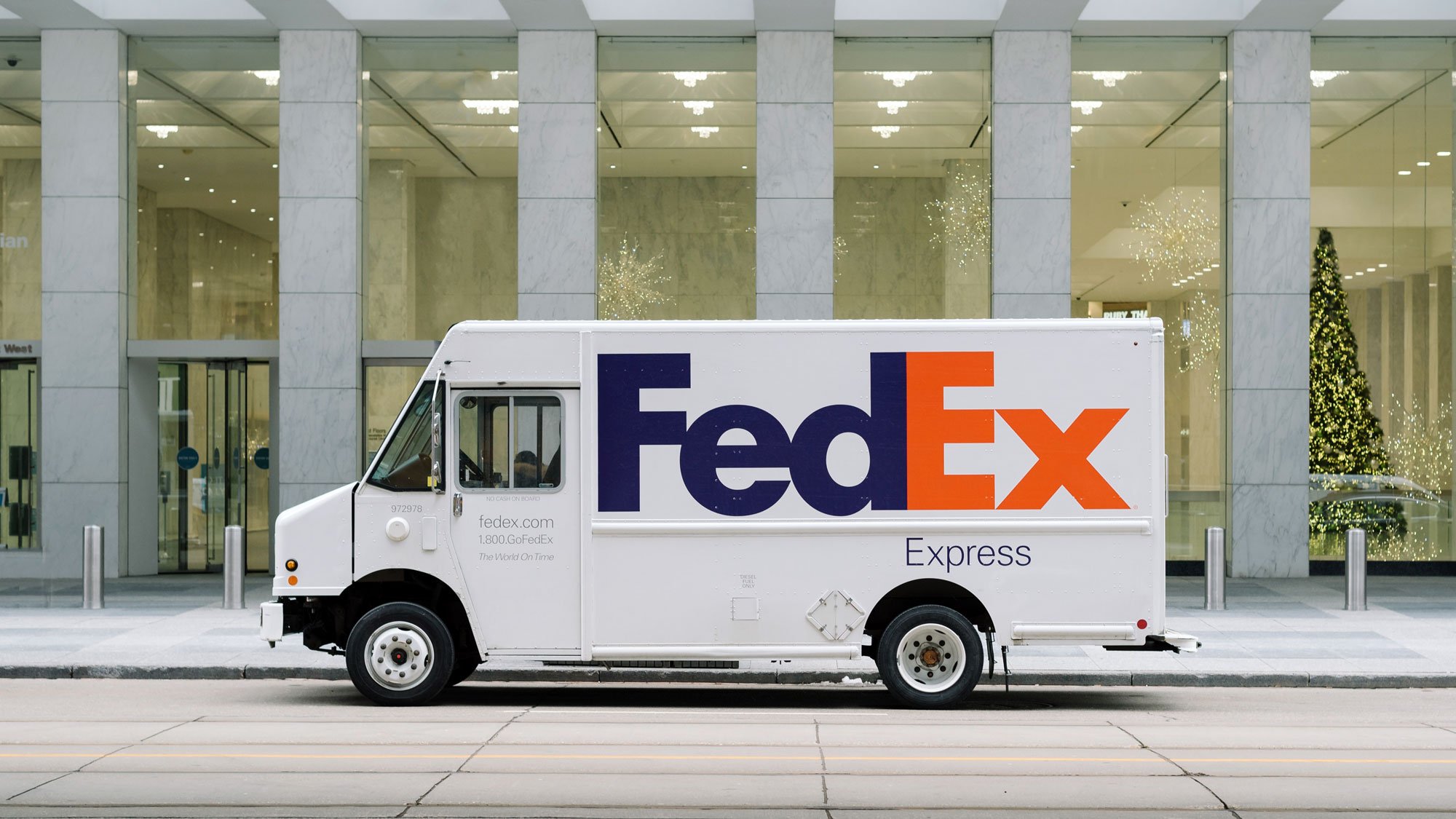 So, FedEx basically invested in IT so that if a product was late the problem was minimized. In a way, this solves a problem that shouldn't even exist with FedEx. In other words, if they always delivered overnight, you wouldn't need to track things because they'd be fully reliable. Well, they weren't totally reliable, but it gave customers and users of the system great comfort to know that if a package was late, it wasn't lost, stolen, or on a truck that burned down or whatever calamity could have happened.
So, FedEx basically invested in IT so that if a product was late the problem was minimized. In a way, this solves a problem that shouldn't even exist with FedEx. In other words, if they always delivered overnight, you wouldn't need to track things because they'd be fully reliable. Well, they weren't totally reliable, but it gave customers and users of the system great comfort to know that if a package was late, it wasn't lost, stolen, or on a truck that burned down or whatever calamity could have happened.
It can tell you that the package left their distribution center in Memphis and has arrived here in our area. You could see if it is in the local warehouse, when it will come, and so on. All of these things had nothing to do with their core product, which involved fleets of planes and fleets of trucks and warehouses. Nothing to do with that. It was simply IT.
And once FedEx put that in place, they dominated the space. I worked with UPS, they were definitely trying to play catch up. This is another area where the first to market wins.
I think what you probably also see with your customers at Viima is that the innovator often gets the greatest market share, and that certainly was the case with FedEx. That’s what I think is the very best example of this historically.
A much more recent and interesting example is with Live Nation. They’re a concert promoter, so they basically sell tickets. They came up with this concept of a 360 Deal. A 360 Deal means that you find an artist, say Madonna, or someone who is a true star. And what you do is you sign up for all the rights you possibly can. These are multi-right solutions, multi-right deals as they're called. That includes merchandise sold at concerts, band websites, brick and mortar retail outlets, revenues from touring, sponsorships, even fan sites. All the ancillary revenues that an artist generates, they now capture. The 360 Deal with Madonna was $120 million over 10 years. I mean, these are real big numbers.
That includes merchandise sold at concerts, band websites, brick and mortar retail outlets, revenues from touring, sponsorships, even fan sites. All the ancillary revenues that an artist generates, they now capture. The 360 Deal with Madonna was $120 million over 10 years. I mean, these are real big numbers.
Would you expect that from someone that sells concert tickets? Actually, they were in the service business, but they had to creativity to expand it by augmenting it with physical tangible products. So, it's not always that you augment a product by adding intangible things.
In the case of the 360 Deal, which I really think is creative, they created a totally new way of capturing more revenue from an artist. Those are the kind exciting examples besides Apple and Amazon that I could think of, but you see them just about everywhere.
JESSE: I guess you just have to be in the mindset of actually looking for those and you'll start to connect the dots and see them all around.
JOHN: Yeah, what you'll find is innovation occurring in all kinds of unexpected areas. For example, in the insurance industry, people are beginning to get smart about how much customer data they have and how they can use these data lakes and AI techniques to extract meaning from them.
I know one insurer that, for example, looks at their susceptible population in order to figure out where to put COVID vaccines or treatments. They actually use the intelligence of the data to be proactive with their service offering. This is an insurance company, but they're getting into other areas through the use of AI and ML.
I think you're seeing more and more companies use data as a way to augment their products or services. This is true in financial services, insurance, banking, and all sorts of industries where they have tons of data.
Companies that have failed in trying to innovate outside the core
JESSE: I'm sure that there are also cases where companies have had difficulties with trying to go beyond the core in their innovation efforts. So, have you seen some companies try this approach but fail?
JOHN: I'm glad you asked this question, Jesse, because this actually stumps me. I haven't. And I think there are several reasons for this.
The first is, remember when I mentioned that in fact, innovating outside the core can actually cost less and get you to market much faster. I mean, look at Live Nation. They can't create a Madonna every year, but what they can do is they can change the deal to make it more encompassing, adding additional products and services to their core musical offerings. Well, the fact of the matter is, these augmented innovations can be easier to innovate than the core, and therefore it is proprietary.
So, I think companies tend to not talk about it because this gets more into the trade secret area. It's a combination of the core technology, plus an added data service, or additional capabilities the customer didn't desire. So, the first is that I think there are more trade secrets here.
The second is that because the investment is lower, the cost of failure is lower, and therefore there could be a number of failures out there but they're just not really big failures.
They're not big failures because the company didn't invest a lot in capital equipment that they had to write off and report that to their shareholders. In general, these kinds of innovations are guided by customer empathy as well as strategy. As they're not trying to do something radical with their customer base, they usually they don't upset customers.
So, they don't upset shareholders, they don't upset customers, and there are trade secrets there. These are pretty obvious reasons, but the one I didn't mention, which I'm sure, is in the back of you and your listeners mind is, that it could be hard. It could be very, very difficult, so there might be very few companies that really succeed at this.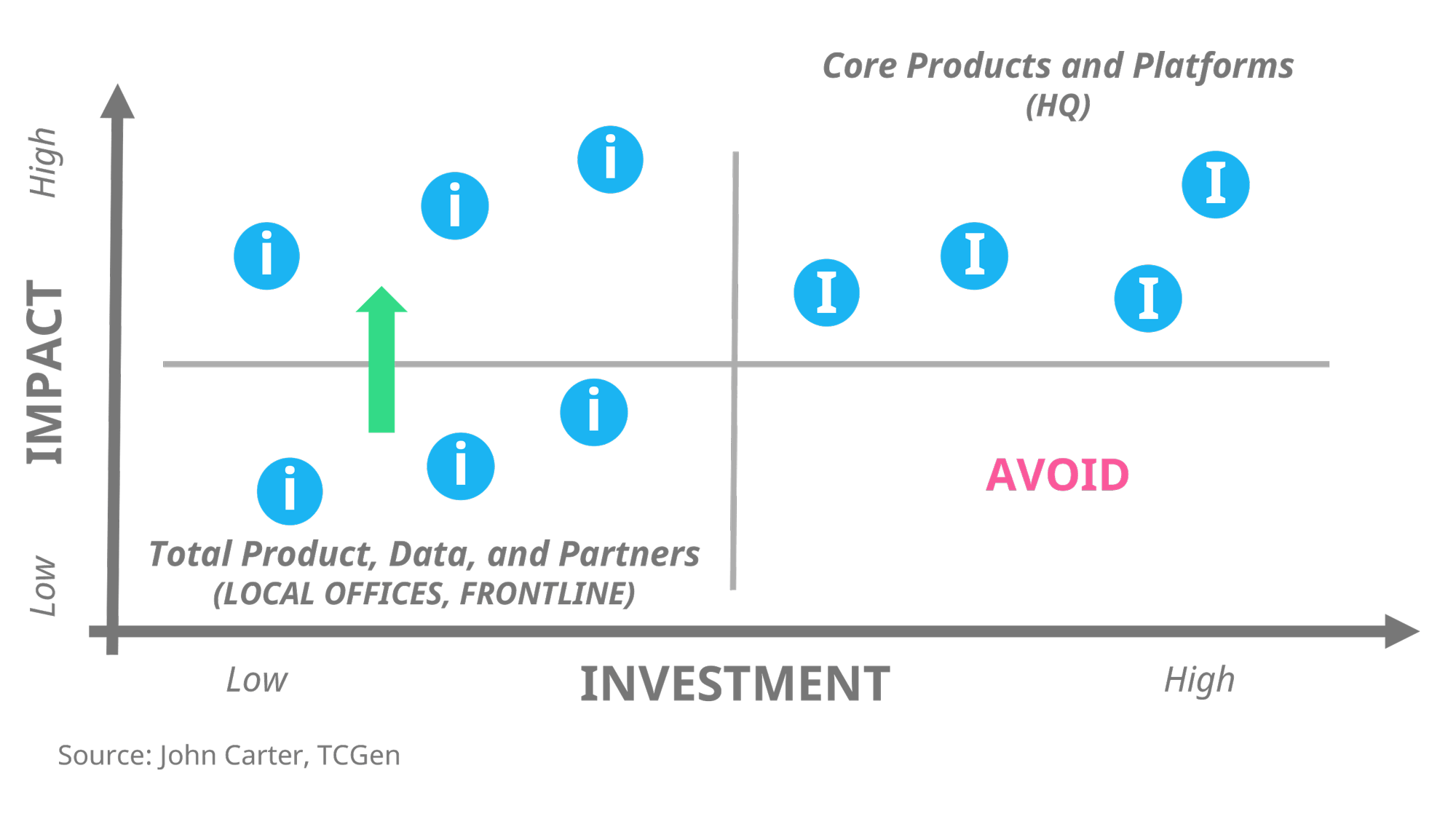 But the fact of the matter is that, given its low investment, given that it’s driven by customer empathy, given that it's dictated or enabled by the corporate strategy, you have a lot of tail winds at your back. And therefore, I don't think it's actually so hard.
But the fact of the matter is that, given its low investment, given that it’s driven by customer empathy, given that it's dictated or enabled by the corporate strategy, you have a lot of tail winds at your back. And therefore, I don't think it's actually so hard.
Now, I think people often look for innovation in the wrong places, and I also wrote about this in a recent Forbes article. They look for innovation in the wrong places, but if you look in the right places and go about it right, you can be successful too.
How to Innovate Beyond the Core
JESSE: Great. I'm sure you have now convinced quite a few of our listeners to put more emphasis on going beyond the core and looking for innovation in those right places. So, I guess the next question naturally is: How can they succeed in it?
JOHN: Again, a really good question if you want to take this insight and be practical about it. Well, I’ve thought about it, and I think specifically I've got some things that might be appealing for the audience.
The first is to draw some sort of strategic or innovation map. Here a Viima board, or other solutions can be excellent tools for you to visualize your innovations and strategies.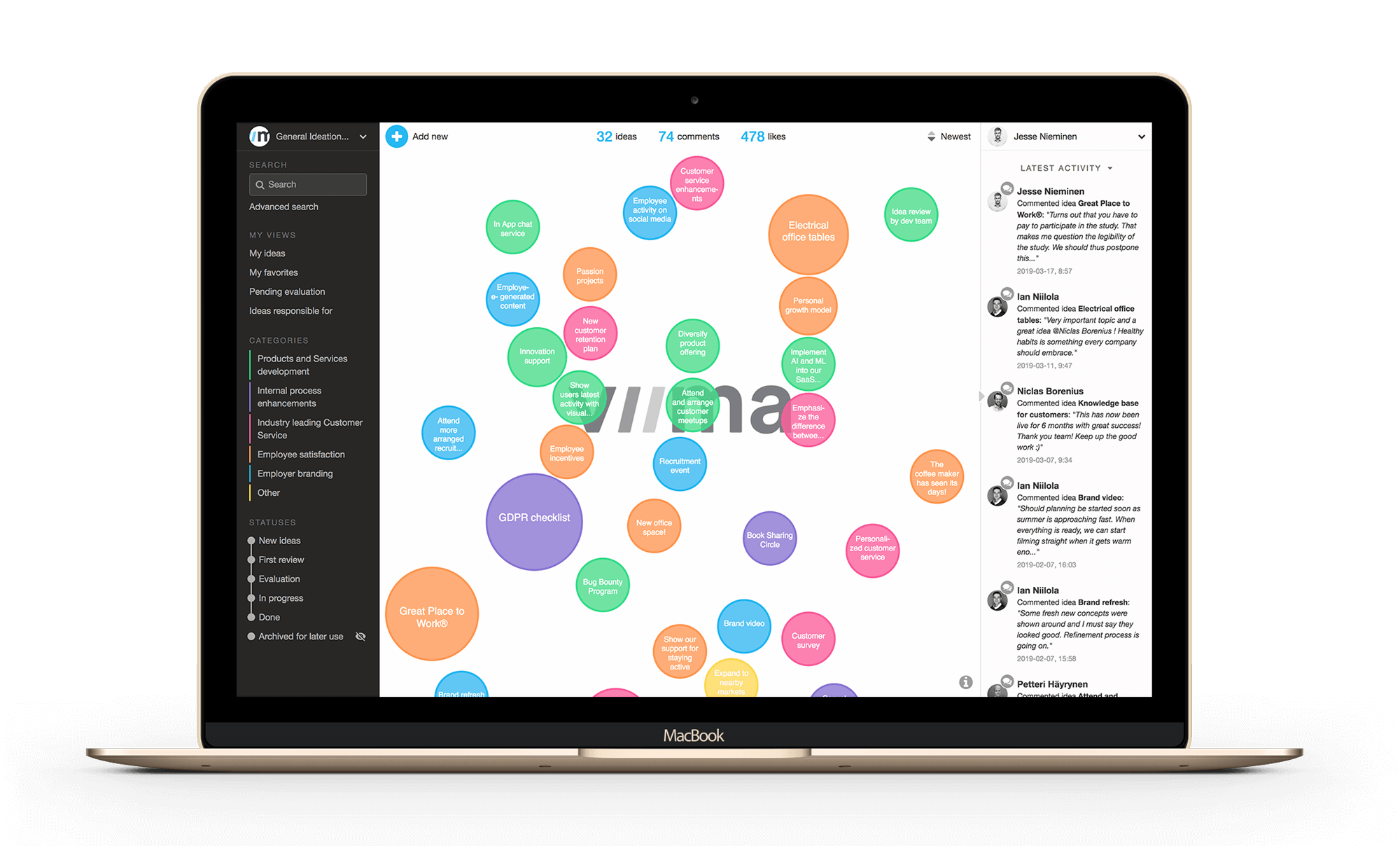 You take that and then you ask the basic question: where do you want to invest in your portfolio? These are usually either:
You take that and then you ask the basic question: where do you want to invest in your portfolio? These are usually either:
- Areas where you’re seeing market growth that would enable you to grow without displacing competition
- Areas where your value proposition is very strong
So, you look at your strategic map or your innovation map, and then you should go about picking an opportunity. I don't mean picking a solution but picking an area for discovery and focusing your efforts there.
I think there are five ways to innovate outside the core. These five steps may help you once you've picked an opportunity in the innovation space to go after.
The first is, to look at information technology. It can provide a platform to help you better understand and serve your customers, so I'd start there.
The second is a little bit more advanced, but it's related to the first, and it’s that data can be turned into insights using artificial intelligence and machine learning. These insights can then lead to new ways to serve and support customers.
For example, in the case of the insurance markets, open things up to new products and services entirely by using data intelligence.
The third is that services can be a big part of the augmented product over the consumption lifecycle, and the margins for services are often much higher than for core products.
A great example is the iPhone ecosystem, where they charge the app developers 30% of their revenue. Their costs to provide that kind of a service are very low. So, think about the margins for services over the consumption cycle. I think people often tend to think about innovation just for making the offering attractive to buy initially. So, look at the consumption lifecycle after the purchase has been made.
The fourth is that content is the new currency and can be bundled with the core offering. Content can come from influencers and from customers. Companies can license it and repurpose it. There are plenty of ways in which you can see content being used.
I think the current dispute that Facebook is having in Australia is a great example of the power of content because the news providers want to charge Facebook for using their stories and Facebook doesn't want to pay, but they've reached an agreement because Facebook has realized that content is king, and they need to provide it.
And finally, the fifth area is that a complete solution can be a win for the consumer and the organization because more value is delivered, and your company can participate in a greater wallet share.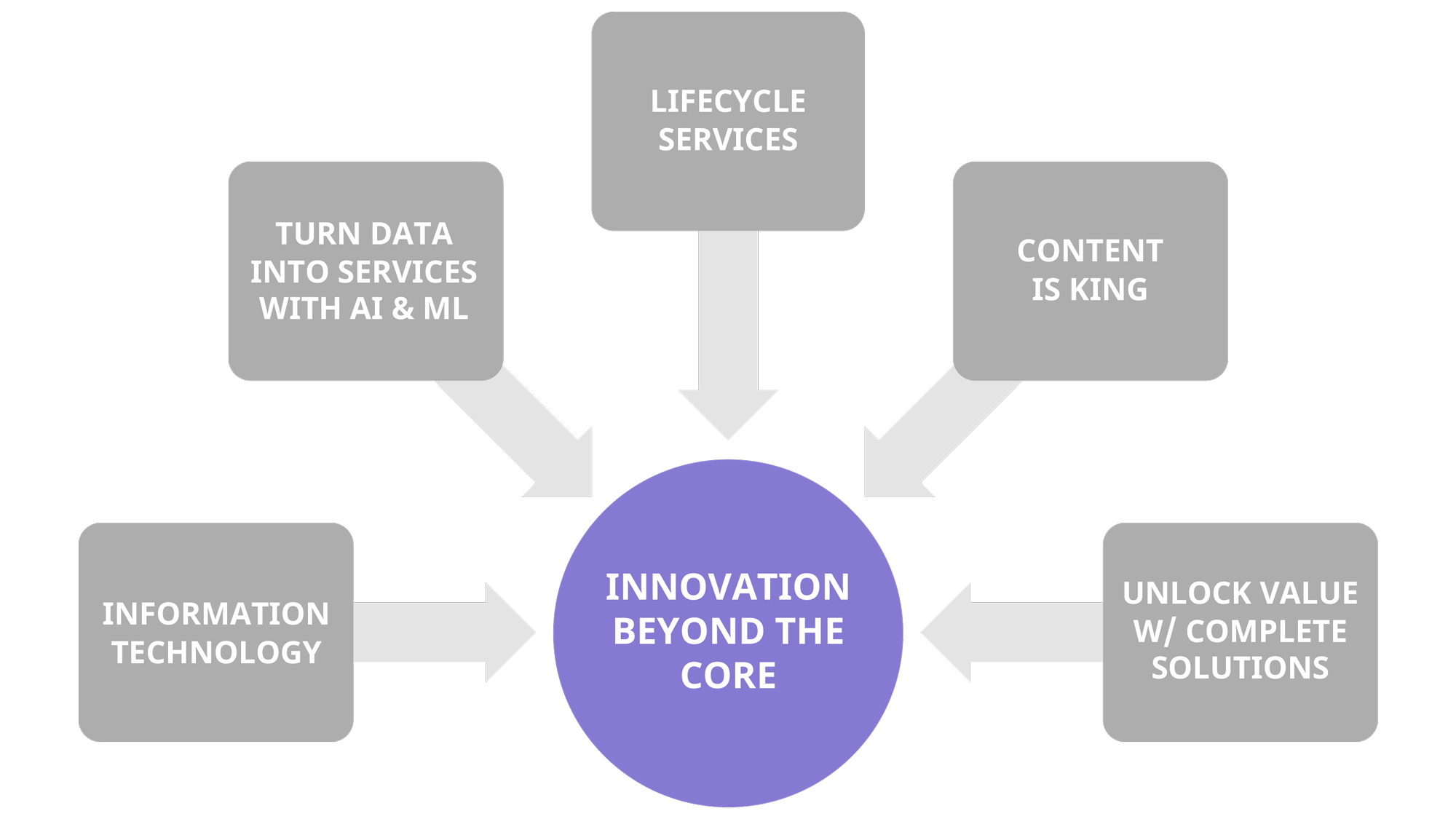 So, think about the value you can provide to your customer and expand its scope and meaning with the customer.
So, think about the value you can provide to your customer and expand its scope and meaning with the customer.
To reiterate, start with the innovation map, and then pick your bets. After that, there are the five techniques I mentioned for innovating outside the core, and I think those are good ways to get started.
JESSE: Yes, and again to recap: Start from the problem or the opportunity instead of going after the solutions.
JOHN: Exactly. Companies all the time get into that trap and they really don't understand what the customer wants. They just want to push more product down their throats without realizing what their needs are.
Getting organizational buy-in
JESSE: We're getting near the end of our episode for today, but before we wrap up, are there some other easy, practical things our listeners could do to get started with this? For example, if their organization, isn't necessarily onboard and hasn't really allocated resources for these kinds of innovations?
JOHN: Sure. I'd start small and prove it out. For companies as small as 10 people, it's still realistic to have some kind of innovation effort on augmenting your core product.
So, I'd start small and then I'd just prove it out. Remember, these are low investments, typically, so I would manage them that way. It’s easy to try them out, and we also talked about the benefits of quick feedback, because you can bring these to market more quickly. So, just try it out.
The second thing I might suggest is a way of thinking about these kinds of investments after you've got your innovation map and you know where you'd like to place your bets. Then, I recommend companies use the 10% rule or the 1% rule, whichever one applies to them.
In the first case, what I recommend is that 10% of their product development be put on innovation. For companies that don't think about product development as a unit or an organization, then put 1% of revenue into innovation. An easy way to remember this is that product development is often 10% of sales. 10% of 10% is 1%. So, use the 1% rule as a guideline.
And the third is that the steps and processes that I outlined above scale with company size. They're not just for a big company. So, just go through the five steps and the starting point with the innovation map. You can do it quickly and then just pick out the steps that work for you. I think that's a good way to get started.
Conclusion
JESSE: Awesome. Thanks, John. Anything else you'd like to say before we wrap up?
JOHN: Yeah, I think the one thing that really sums it up for me is to remember that the customer doesn't buy a core product, they want a job to be done.
The customer doesn’t buy a core product; they want a job to be done.
For example, a homemaker does not want to buy a better mop. They want cleaner floors. So, think about the job to be done rather than a product or solution.
JESSE: Perfect. That's a great place to wrap up on. Thanks for being on the show John!
